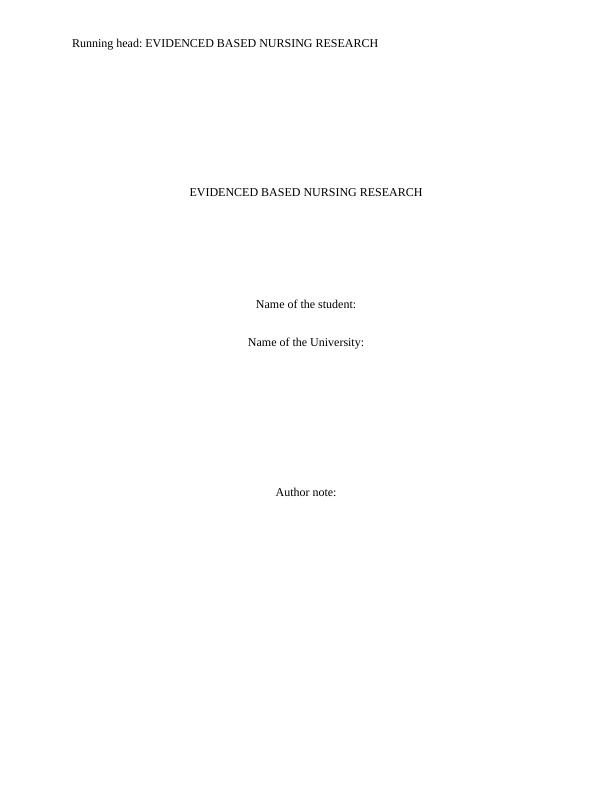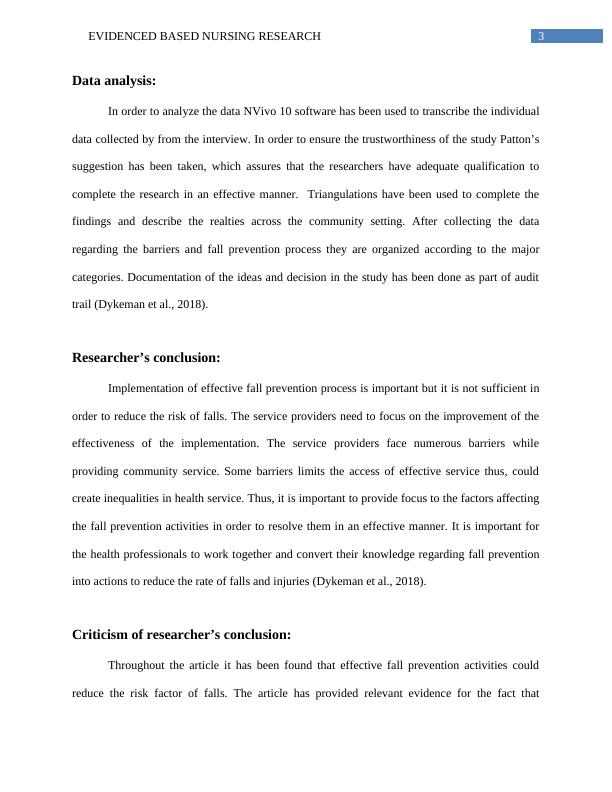Evidenced Based Nursing Research
Added on 2023-06-10
13 Pages3215 Words107 Views
Running head: EVIDENCED BASED NURSING RESEARCH
EVIDENCED BASED NURSING RESEARCH
Name of the student:
Name of the University:
Author note:
EVIDENCED BASED NURSING RESEARCH
Name of the student:
Name of the University:
Author note:

1EVIDENCED BASED NURSING RESEARCH
Qualitative article: Community service provider perceptions of implementing
older adult fall prevention in Ontario, Canada: a qualitative study
Background:
According to the evidence majority of the cases related to falls are predictable and the
injuries caused by the falls are preventable. There is a negative impact of the unintentional falls
and injuries among the person aged 65 years and more on the health care resources and the
quality of life of the old aged person of Canada. In Canada the rate of falls in the older adults per
year is 20-30%. Many studies have been indicated that adequate interventions are present that are
effective in order to reduce the risk factors of falls and injuries. However, the health care service
providers face some barriers in order to provide such fall prevention strategies. The purpose of
the study is to explore the barriers of the falls prevention strategy and introduce effective the
evidenced based fall prevention strategies to reduce the risk of falls. It would help to identify the
process that could help t reduce the rate of falls and injuries in the population (Dykeman et al.,
2018).
Review of the literature:
The increasing risk of falls and injuries has become the concern of the health care service
providers. Evidence has proved that most of the incidents of falls are predictable and the injuries
caused by the incidents are preventable. The people aged 65 years and more are susceptible to
falls. The rate of falls in the older adults in Canada is 20-30% that has a negative impact on the
health service and the standard of life of the older adults in Canada. According to some study
Qualitative article: Community service provider perceptions of implementing
older adult fall prevention in Ontario, Canada: a qualitative study
Background:
According to the evidence majority of the cases related to falls are predictable and the
injuries caused by the falls are preventable. There is a negative impact of the unintentional falls
and injuries among the person aged 65 years and more on the health care resources and the
quality of life of the old aged person of Canada. In Canada the rate of falls in the older adults per
year is 20-30%. Many studies have been indicated that adequate interventions are present that are
effective in order to reduce the risk factors of falls and injuries. However, the health care service
providers face some barriers in order to provide such fall prevention strategies. The purpose of
the study is to explore the barriers of the falls prevention strategy and introduce effective the
evidenced based fall prevention strategies to reduce the risk of falls. It would help to identify the
process that could help t reduce the rate of falls and injuries in the population (Dykeman et al.,
2018).
Review of the literature:
The increasing risk of falls and injuries has become the concern of the health care service
providers. Evidence has proved that most of the incidents of falls are predictable and the injuries
caused by the incidents are preventable. The people aged 65 years and more are susceptible to
falls. The rate of falls in the older adults in Canada is 20-30% that has a negative impact on the
health service and the standard of life of the older adults in Canada. According to some study

2EVIDENCED BASED NURSING RESEARCH
with the implementation of the fall prevention activities in the population the risk of falls could
be reduced by 24%. However, it has been detected that the rate of falls in the older adults is
remained unchanged and it is high for the women aged from 65-70 years in the community.
Thus, the need of fall prevention process has become high in the recent days. In thus regards
evidence has shown that some factors are there that affect the implementation of the fall
prevention strategies and create barriers for the service providers, for example, lack of
communication and coordination between different health care organizations, insufficient
resources, lack of access or unequal access to the service and many others. Thus, the service
providers need to be focused on the factors and introduce effective interventions to resolve the
issue and reduce the risk of falls in the population ((Dykeman et al., 2018).
Discussion of Methodology:
The risk factor of falls varies according to the age, gender and population. Thus, the study
has chosen different areas such as North Bay Parry sound District Health Unit, Public health unit
in Ontario, Simoco Muskoka district Health Unit and York region Public Health Service as the
sample of the study. The researchers have worked with the staffs of the organizations in order to
understand the fall prevention activities. The staffs of the organization have contacted
participants from different levels such as managers, supervisors and frontlines. The people that
are interested in participation in the study have been informed about the study process. Common
interview has been conducted for the participants. Relevant questions related to types of fall
prevention activities in the organization, additional activities, factors that creates obstacle, new
interventions have been asked to the interviewee. The study has included broad sample size in
order to introduce broad discussion (Dykeman et al., 2018).
with the implementation of the fall prevention activities in the population the risk of falls could
be reduced by 24%. However, it has been detected that the rate of falls in the older adults is
remained unchanged and it is high for the women aged from 65-70 years in the community.
Thus, the need of fall prevention process has become high in the recent days. In thus regards
evidence has shown that some factors are there that affect the implementation of the fall
prevention strategies and create barriers for the service providers, for example, lack of
communication and coordination between different health care organizations, insufficient
resources, lack of access or unequal access to the service and many others. Thus, the service
providers need to be focused on the factors and introduce effective interventions to resolve the
issue and reduce the risk of falls in the population ((Dykeman et al., 2018).
Discussion of Methodology:
The risk factor of falls varies according to the age, gender and population. Thus, the study
has chosen different areas such as North Bay Parry sound District Health Unit, Public health unit
in Ontario, Simoco Muskoka district Health Unit and York region Public Health Service as the
sample of the study. The researchers have worked with the staffs of the organizations in order to
understand the fall prevention activities. The staffs of the organization have contacted
participants from different levels such as managers, supervisors and frontlines. The people that
are interested in participation in the study have been informed about the study process. Common
interview has been conducted for the participants. Relevant questions related to types of fall
prevention activities in the organization, additional activities, factors that creates obstacle, new
interventions have been asked to the interviewee. The study has included broad sample size in
order to introduce broad discussion (Dykeman et al., 2018).

3EVIDENCED BASED NURSING RESEARCH
Data analysis:
In order to analyze the data NVivo 10 software has been used to transcribe the individual
data collected by from the interview. In order to ensure the trustworthiness of the study Patton’s
suggestion has been taken, which assures that the researchers have adequate qualification to
complete the research in an effective manner. Triangulations have been used to complete the
findings and describe the realties across the community setting. After collecting the data
regarding the barriers and fall prevention process they are organized according to the major
categories. Documentation of the ideas and decision in the study has been done as part of audit
trail (Dykeman et al., 2018).
Researcher’s conclusion:
Implementation of effective fall prevention process is important but it is not sufficient in
order to reduce the risk of falls. The service providers need to focus on the improvement of the
effectiveness of the implementation. The service providers face numerous barriers while
providing community service. Some barriers limits the access of effective service thus, could
create inequalities in health service. Thus, it is important to provide focus to the factors affecting
the fall prevention activities in order to resolve them in an effective manner. It is important for
the health professionals to work together and convert their knowledge regarding fall prevention
into actions to reduce the rate of falls and injuries (Dykeman et al., 2018).
Criticism of researcher’s conclusion:
Throughout the article it has been found that effective fall prevention activities could
reduce the risk factor of falls. The article has provided relevant evidence for the fact that
Data analysis:
In order to analyze the data NVivo 10 software has been used to transcribe the individual
data collected by from the interview. In order to ensure the trustworthiness of the study Patton’s
suggestion has been taken, which assures that the researchers have adequate qualification to
complete the research in an effective manner. Triangulations have been used to complete the
findings and describe the realties across the community setting. After collecting the data
regarding the barriers and fall prevention process they are organized according to the major
categories. Documentation of the ideas and decision in the study has been done as part of audit
trail (Dykeman et al., 2018).
Researcher’s conclusion:
Implementation of effective fall prevention process is important but it is not sufficient in
order to reduce the risk of falls. The service providers need to focus on the improvement of the
effectiveness of the implementation. The service providers face numerous barriers while
providing community service. Some barriers limits the access of effective service thus, could
create inequalities in health service. Thus, it is important to provide focus to the factors affecting
the fall prevention activities in order to resolve them in an effective manner. It is important for
the health professionals to work together and convert their knowledge regarding fall prevention
into actions to reduce the rate of falls and injuries (Dykeman et al., 2018).
Criticism of researcher’s conclusion:
Throughout the article it has been found that effective fall prevention activities could
reduce the risk factor of falls. The article has provided relevant evidence for the fact that

End of preview
Want to access all the pages? Upload your documents or become a member.
Related Documents
NURS2006 Assignment 5 - Clinical Practice Improvement Project Reportlg...
|9
|2842
|420
Clinical Practice Improvement Project Report on Accidental Fall Prevention among Older Adultslg...
|9
|2850
|417
Falls Prevention among elderly individuals Assignment PDFlg...
|21
|3680
|29
Effectiveness of Exercise-Based Interventions in Reducing Falls in Older Adults Living in Residential Care Facilitieslg...
|12
|6103
|343
Injury Prevention Report 2022lg...
|12
|2263
|18
Risk factors for unintentional injuries among the rural elderly: a county-based cross-sectional surveylg...
|9
|8899
|204
